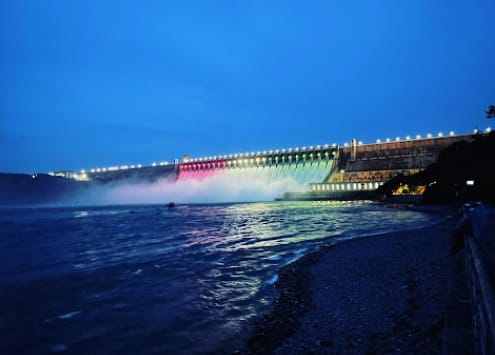Checkout Nagarjuna Sagar Dam, Andhra Pradesh Watch Video
Introduction
Nestled amidst the picturesque landscapes of Andhra Pradesh, the Nagarjuna Sagar Dam stands tall as an engineering marvel and a testament to human ingenuity. This monumental structure, built across the Krishna River, is not only a crucial source of irrigation and power but also a haven for nature enthusiasts and history buffs. Let’s delve deeper into what makes this destination a must-visit.
Timings and Entry
- Timings: Nagarjuna Sagar Dam is open to visitors from 8:30 AM to 6:00 PM on all days of the week.
- Entry Fees: There is a nominal entry fee for visitors, which may vary for domestic and international tourists.
- Video and Photo Charges: Photography and videography are permitted, but a small fee may be charged for commercial purposes.
Best Time to Visit
The best time to explore Nagarjuna Sagar Dam is during the post-monsoon months of September to February when the weather is pleasant, and the surrounding greenery is at its prime. Avoid visiting during the scorching summer months of April to June.
Historical Significance
The Nagarjuna Sagar Dam, named after the renowned Buddhist monk Acharya Nagarjuna, was constructed between 1955 and 1967. It is the world’s largest masonry dam and a key project for irrigation and hydroelectric power generation.
Scenic Beauty
Apart from its engineering brilliance, the dam offers breathtaking views of the Krishna River flowing through the lush Nallamala Hills. The reservoir created by the dam, known as Nagarjuna Sagar Lake, is a haven for migratory birds, making it a paradise for birdwatchers.
Ethereal Ethnographic Museum
Adjacent to the dam is the Ethnographic Museum which showcases the rich cultural heritage of the region. It houses a captivating collection of sculptures, artifacts, and inscriptions that provide insights into the historical and cultural evolution of the area.
Suggestions for Different Travelers
For Families with Kids
- Engage your children with the interactive exhibits at the Ethnographic Museum.
- Enjoy a leisurely boat ride on Nagarjuna Sagar Lake, providing an educational and enjoyable experience.
For Older Visitors
- Consider taking a guided tour to ensure a comfortable and informative visit.
- Enjoy the serene ambience of the dam and its surroundings while taking short breaks at the designated rest areas.
- One has to walk more and take steps when visiting this place.
Not to Miss
- Sound and Light Show: The dam comes alive after sunset with a captivating sound and light show that narrates the history and significance of Nagarjuna Sagar.
- Boat Ride: Take a boat ride to get up close to the dam and relish the breathtaking views.
Nagarjuna Sagar Dam is a blend of historical significance, natural beauty, and architectural brilliance. Whether you’re a history enthusiast, a nature lover, or simply looking for a serene escape, this destination has something for everyone. So, plan your visit and immerse yourself in the grandeur of this iconic structure.
Frequently Asked Questions
Yes, Nagarjuna Sagar Dam provides ample parking space for both two-wheelers and four-wheelers.
There are several eateries and food stalls around the dam area where visitors can relish local delicacies.


